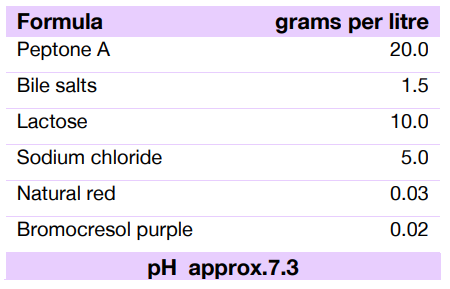Description
MacConkey Broth | DM150D
A selective medium for the examination of milk and water.
MacConkey Broth has for many years been used as an indicator of faecal contamination of water, and the possible presence of
pathogenic organisms such as salmonellae and shigellae. Acid or gas production from the fermentation of lactose is used as a
partial diagnostic feature. Growth at 44°C is used as a confirmatory diagnostic test. MAST MacConkey Broth uses bromocresol
purple as a more suitable indicator of acid production. Childs and Allan (1953) showed that certain batches of neutral red inhibited the growth of E.coli. As recommended by the Ministry of Health (1969) and by Burman (1955), the bile salts and peptone used for this formulation of MacConkey broth are very carefully controlled to reduce their variability.
Directions
1. For single strength MacConkey Broth suspend 36.5g of powder in 1 litre or the contents of the sachet in the stated volume
of distilled or deionised water.
2. Distribute into test tubes or suitable bottles containing Durham's tubes.
3. Autoclave at 121°C (15p.s.i.) for 15 minutes.
Technical Formula

In Use
Tubes of broth are inoculated by the Ministry of Health (1969)2 recommended method, and incubated at 37°C for 18-24
hours. 'A presumptive positive test' is shown by acid production (colour change from purple to yellow) and gas production
in the Durham tube. The most probable number of coliforms per 100ml water is obtained from McGrady's tables. Confirmation of positive results is carried out by subculture onto solid media such as MAST Endo Agar (DM135) or MAST MacConkey Agar (without salt) (DM140).






